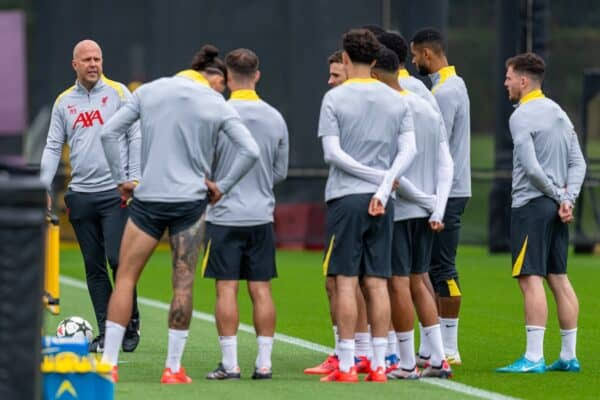Liverpool’s Defensive Evolution: Tactical Flexibility in Modern Football

In the ever-evolving landscape of modern football, tactical flexibility has become not just an advantage but a necessity. Liverpool Football Club, under the guidance of their coaching staff, exemplifies this principle through their innovative approach to defensive positioning and player utilization. The concept of deploying versatile players in unconventional roles has become a hallmark of contemporary football tactics, and Liverpool’s recent strategic decisions offer a fascinating case study in adaptive team management.
The modern game demands more from players than ever before. Gone are the days when a midfielder was simply a midfielder, or a defender purely focused on defensive duties. Today’s football requires players who can seamlessly transition between roles, adapt to different tactical systems, and provide solutions to unexpected problems. This evolution has created opportunities for clubs to maximize their investment in players while simultaneously addressing multiple tactical needs.
The full-back position has undergone perhaps the most dramatic transformation in recent decades. What was once primarily a defensive role has evolved into a position that demands attacking prowess, creative vision, and exceptional physical conditioning. Modern full-backs are expected to contribute significantly in both phases of play, often covering more ground than any other player on the pitch.
This evolution has created unique challenges for team managers. The physical demands of the modern full-back role often lead to fatigue and injury concerns, particularly given the intense pressing and overlapping runs required in high-tempo tactical systems. When injuries occur, finding suitable replacements becomes increasingly complex, as the role demands such a specific skill set.
Liverpool’s approach to this challenge reflects broader trends in football tactics. Rather than simply rotating like-for-like players, modern coaches are increasingly willing to experiment with positional flexibility. This approach not only provides immediate solutions to personnel problems but also creates tactical unpredictability that can confuse opponents.
The concept of deploying midfielders in defensive positions is not entirely new, but its application has become more sophisticated and strategic. Players who possess the technical ability, tactical intelligence, and physical attributes to excel in multiple positions represent enormous value to modern football clubs. This versatility extends beyond mere squad depth; it opens up tactical possibilities that can provide competitive advantages.
When considering the deployment of a midfielder in a full-back role, several factors come into play. The player’s passing ability, spatial awareness, and defensive understanding become crucial. Modern football systems often require full-backs to contribute to build-up play, making accurate passing and decision-making under pressure essential skills. A midfielder naturally possesses many of these attributes, having developed them in central areas where time and space are often limited.
The tactical benefits of such deployment extend beyond individual performance. A midfielder playing at full-back can provide different passing angles and create unexpected attacking patterns. Their natural tendency to drift inward can create space for wingers to exploit, while their comfort in possession can help teams maintain control during build-up phases.
The transition from central midfield to full-back requires specific physical and mental adaptations. The role demands different types of runs, positioning, and spatial awareness. While a midfielder might be accustomed to covering large areas of the pitch vertically, the full-back role requires more lateral movement and the ability to defend wide areas effectively.
Defensively, the challenges are significant. Full-backs must be comfortable in one-on-one situations, understand when to engage attackers and when to contain them, and possess the recovery pace to deal with counter-attacks. For a midfielder adapting to this role, developing these defensive instincts becomes crucial.
However, the attacking phase might actually suit a midfielder’s natural abilities. The modern game’s emphasis on inverted full-backs – players who cut inside to support central areas – aligns well with a midfielder’s natural inclinations. This tactical trend has made the transition between positions more seamless than it might have been in previous eras.
Modern tactical systems increasingly accommodate and even encourage positional interchange. The concept of fluid formations, where players rotate positions during different phases of play, has become commonplace at the highest levels of football. This flexibility allows teams to adapt to different game situations without making substitutions.
The 4-3-3 formation, popular among many top clubs, naturally lends itself to such flexibility. In this system, full-backs often push high during attacking phases, while midfielders can drop deeper to provide cover. The lines between positions become blurred, creating a more dynamic and unpredictable tactical setup.
This tactical evolution has influenced how clubs approach player recruitment and development. Rather than seeking specialists for each position, clubs increasingly value players who can contribute in multiple roles. This approach maximizes squad efficiency and provides coaches with more options when facing tactical challenges.
From a financial standpoint, versatile players represent excellent value for money. The modern transfer market demands increasingly high fees for quality players, making it essential for clubs to maximize their investment. A player capable of performing effectively in multiple positions essentially provides the utility of several players, justifying higher transfer fees and wages.
This economic reality has influenced how clubs approach squad building. Rather than maintaining large squads with specialists for each position, many successful teams now prefer smaller, more versatile squads. This approach reduces wage bills while maintaining tactical flexibility and competitive depth.
The concept also applies to player development within club academies. Young players who demonstrate versatility and tactical intelligence often receive priority in development programs, as their potential value to the first team is greater than that of position-specific specialists.
Football history is replete with examples of successful positional transformations. Many legendary players began their careers in different positions before finding their optimal role. The game’s tactical evolution has accelerated this trend, with players increasingly required to understand multiple roles within team systems.
The Dutch concept of “Total Football” pioneered many ideas about positional interchange that remain relevant today. While few teams attempt to implement such radical positional fluidity, the underlying principles of tactical flexibility and player versatility continue to influence modern football thinking.
Contemporary examples abound of players who have successfully transitioned between positions. The key factors in successful transitions typically include tactical intelligence, physical adaptability, and mental flexibility. Players who possess these attributes often thrive in new roles, sometimes even improving their overall performance.
Implementing positional flexibility requires specific training approaches. Players must develop understanding of different roles through both theoretical study and practical application. This process involves analyzing the tactical requirements of each position, understanding spatial relationships, and developing the physical attributes necessary for success.
Modern training methods increasingly emphasize positional flexibility. Many clubs now include regular sessions where players practice in different roles, developing the tactical understanding necessary for successful transitions. This approach not only prepares players for emergency situations but also enhances their overall football intelligence.
The psychological aspect of positional change cannot be underestimated. Players must develop confidence in unfamiliar roles while maintaining their core strengths. Successful transitions often require mental resilience and willingness to embrace new challenges.
Deploying players in unconventional positions can provide significant tactical advantages. Opponents often struggle to prepare for unusual formations or player deployments, potentially creating confusion in their defensive or attacking structures. This unpredictability can be particularly valuable in crucial matches where marginal advantages become decisive.
The element of surprise extends beyond individual matches. Teams that regularly employ tactical flexibility force opponents to prepare for multiple scenarios, potentially diluting their focus on specific tactical plans. This strategic advantage can be particularly valuable over the course of a season.
Furthermore, tactical flexibility allows teams to adapt to different game situations without making substitutions. A midfielder playing at full-back might be better suited to defending a lead than a more attack-minded natural full-back, providing in-game tactical adjustments that don’t require personnel changes.
Despite its advantages, positional flexibility also presents challenges. Players performing in unfamiliar roles may initially struggle with positioning, timing, and decision-making. These difficulties can potentially compromise team performance, particularly in high-pressure situations.
The physical demands of different positions can also create problems. A midfielder might lack the specific conditioning required for full-back play, potentially leading to fatigue or injury concerns. Careful management of player workload becomes essential when implementing such tactical changes.
There’s also the risk of compromising a player’s development in their natural position. Excessive role rotation might prevent players from reaching their full potential in their optimal position, potentially limiting both individual and team performance in the long term.
The trend toward positional flexibility shows no signs of diminishing. As tactical systems become increasingly sophisticated, the demand for versatile players will likely continue to grow. This evolution may fundamentally change how we think about player positions and team formation.
Technology and data analysis are playing increasing roles in identifying players suitable for positional transitions. Advanced metrics can help coaches understand which players possess the attributes necessary for success in different roles, making tactical experimentation more scientific and less risky.
The development of hybrid positions may become more common, with players specifically trained to excel in multiple roles rather than mastering a single position. This evolution could reshape football tactics and player development philosophies.
Liverpool’s tactical flexibility reflects broader trends in modern football. The game’s increasing pace, tactical complexity, and physical demands require adaptive approaches to team management. Clubs that successfully implement flexible tactical systems often enjoy competitive advantages over more rigid opponents.
The influence of coaching education and tactical innovation continues to drive these trends. As coaches become more sophisticated in their tactical understanding, they develop new approaches to traditional problems. Positional flexibility represents one such innovation that has gained widespread acceptance.
The global nature of modern football also contributes to tactical evolution. Ideas and innovations spread rapidly between leagues and countries, accelerating the adoption of successful tactical concepts. This interconnectedness ensures that innovative approaches like positional flexibility quickly become standard practice.
The deployment of versatile players in unconventional roles represents the evolution of modern football tactics. Success in contemporary football often depends not just on having the best players, but on using them most effectively. This principle extends beyond individual matches to encompass entire seasons and tactical philosophies.
Liverpool’s approach to defensive flexibility exemplifies how modern clubs maximize their resources while maintaining competitive performance. By developing players capable of excelling in multiple positions, clubs create tactical options that can prove decisive in crucial moments.
The future of football will likely see continued emphasis on versatility and tactical flexibility. Players who can adapt to different roles and systems will become increasingly valuable, while coaches who can implement such flexibility effectively will enjoy significant advantages.
This evolution reflects football’s continuous development as both an art and a science. The game’s beauty lies partly in its unpredictability and creativity, qualities enhanced by tactical innovation and player versatility. As football continues to evolve, the principles of adaptation and flexibility will remain central to successful team management.
The modern game rewards those who can think differently, adapt quickly, and maximize available resources. In this context, tactical flexibility becomes not just a useful tool but an essential component of competitive success. Liverpool’s approach serves as an excellent example of how contemporary football clubs can navigate the complex challenges of modern football through intelligent player utilization and tactical innovation.














